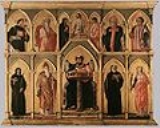
San Luca Altarpiece
Encyclopedia
The San Luca Altarpiece, also known as the San Luca Polyptych, is a polyptych
panel painting
by Northern Italian Renaissance
painter Andrea Mantegna
. The altarpiece is a polyptych panel painting featuring 12 figures each in his or her own arch. The seven figures in the top row flank the central figure of Jesus Christ. The five beneath flank Saint Luke
.
. In return for 50 ducats, Mantegna agreed to complete the work, providing paints with which to depict the figures and the azzurro Todesco (a blue pigment derived from copper
) with which to inlay them. The work was completed within that or the following year. The polyptych is located in Pinacoteca di Brera, Milan
.
Polyptych
A polyptych generally refers to a painting which is divided into sections, or panels. The terminology that follows is in relevance to the number of panels integrated into a particular piece of work: "diptych" describes a two-part work of art; "triptych" describes a three-part work; "tetraptych"...
panel painting
Panel painting
A panel painting is a painting made on a flat panel made of wood, either a single piece, or a number of pieces joined together. Until canvas became the more popular support medium in the 16th century, it was the normal form of support for a painting not on a wall or vellum, which was used for...
by Northern Italian Renaissance
Italian Renaissance
The Italian Renaissance began the opening phase of the Renaissance, a period of great cultural change and achievement in Europe that spanned the period from the end of the 13th century to about 1600, marking the transition between Medieval and Early Modern Europe...
painter Andrea Mantegna
Andrea Mantegna
Andrea Mantegna was an Italian painter, a student of Roman archeology, and son in law of Jacopo Bellini. Like other artists of the time, Mantegna experimented with perspective, e.g., by lowering the horizon in order to create a sense of greater monumentality...
. The altarpiece is a polyptych panel painting featuring 12 figures each in his or her own arch. The seven figures in the top row flank the central figure of Jesus Christ. The five beneath flank Saint Luke
Luke the Evangelist
Luke the Evangelist was an Early Christian writer whom Church Fathers such as Jerome and Eusebius said was the author of the Gospel of Luke and the Acts of the Apostles...
.
History
On August 10, 1453, Mantegna signed a contract to paint the work for the monastery of Santa Giustina in PaduaPadua
Padua is a city and comune in the Veneto, northern Italy. It is the capital of the province of Padua and the economic and communications hub of the area. Padua's population is 212,500 . The city is sometimes included, with Venice and Treviso, in the Padua-Treviso-Venice Metropolitan Area, having...
. In return for 50 ducats, Mantegna agreed to complete the work, providing paints with which to depict the figures and the azzurro Todesco (a blue pigment derived from copper
Copper
Copper is a chemical element with the symbol Cu and atomic number 29. It is a ductile metal with very high thermal and electrical conductivity. Pure copper is soft and malleable; an exposed surface has a reddish-orange tarnish...
) with which to inlay them. The work was completed within that or the following year. The polyptych is located in Pinacoteca di Brera, Milan
Milan
Milan is the second-largest city in Italy and the capital city of the region of Lombardy and of the province of Milan. The city proper has a population of about 1.3 million, while its urban area, roughly coinciding with its administrative province and the bordering Province of Monza and Brianza ,...
.

